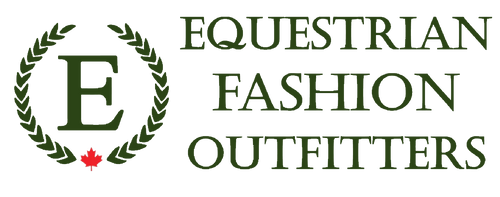Winter Riding Must-Haves!
Step 1: Base Layer

Our favourite base layer from this winter’s collection is the QHP Loua Heated Thermal Shirt. The QHP Loua is an essential winter horseback riding base layer shirt to keep us warm, even on the coldest of days. The shirts main feature is its unique special inner print that is designed to regulate body heat with moisture wicking fabric. So, we are free to work up a sweat without having to worry about becoming damp or cold. Bonus: the shirts fabric is super soft and cozy!
Step 2: Light Jacket or Zip Sweater
Now that we have our base layer covered, next up is what we like to call our insulating layer. The insulating layer is slightly heavier than our base layer, it often has a fleece lining and always has either a quarter, half or full zip closure. The opening is essential to help us self-regulate our own body temperature. Getting a little hot while mucking stalls or riding? No problem, unzip this layer to offer your body some extra ventilation. Getting a little cold? Simply zip this layer back up to regain warmth and coziness. The main purpose of the insulating layer for Canadian equestrians is to ensure that we have the option to cool down or warm up. Some opt to wear just a base layer or just an insulating layer, it all depends on the weather conditions where you will be riding.

This year’s favourite zip jacket/sweater for insulation during winter horseback riding is the HKM KIDS Fleece Jacket. The HKM Fleece Jacket is a stunningly soft horseback riding jacket ideal for use as a mid-layer or insulation layer piece of clothing. It is a warm riding jacket with a high collar to keep the wind out and the warmth in. Easily unzip the full zip closure at the front to cooldown if temperatures start to rise. Our favourite feature: it has two pockets with a velour finish to keep your hands (or treats) warm!
Step 3: Heavy Winter Jacket
There are a few ways to approach the final upper body layer for winter horseback riding. Some of our team opt to add an additional insulation layer, such as a vest or additional sweater, but most choose to forego the vest layer and go straight for the heavy winter jacket. This layer is mainly used for coming and going from the barn: turning in/out, walking fence lines, coaching, or anything that requires you to embrace the winter elements full on. The most essential feature of this layer is that your jacket is waterproof or water resistant! During Canadian winters we experience everything from snow, sleet, rain, or hail. We must make sure our jacket can keep up with mother nature!

B Vertigo Dana Padded Winter Jacket
Back for another year, our favourite winter jacket has been the B Vertigo Dana Winter Jacket. It is jam packed with functional detail to make your life easier in the winter. Not only does the Dana jacket look gorgeous, it also offers warmth and comfort as well. Made from stretchy, breathable, warm, and waterproof material, it really is a jacket that can keep up to the constantly changing winter weather. Unique features of this jacket are the magnetic buttons (so your saddle will not get scratched), two-way zipper (keeps you comfortable in and out of the saddle) and reflective details (to keep you visible at night)!
Step 4: Winter Breeches
Okay, so we have covered our upper body but what about our lower body? This is where being a Canadian equestrian really gets put to the test. As we still need to be able to sit in the saddle without our breeches sliding around on us, the lower body layers are the toughest to master. On the very cold days we always suggest beginning with a base layer of leggings or thermal underwear – however, we found this to be of personal preference, and some of us opt to have no base layer at all! Winter breeches are mainly fleece or thermal lined pants with a full or knee patch seat. For some strange reason we feel that the full seat winter breeches provide a touch more warmth than the knee patch winter breeches, but that could also be a trick of the mind!

Horze Thermal Grand Prix Breeches
Year after year, our hands down favourite winter breeches have been the Horze Thermal Breeches they fit a bit large, so we recommend to always size down.

However, this year a new contender has come to the winter breeches arena – the BR Suus Thermal Treggings! The BR Suus Thermal Treggings are a great all-around horseback riding pant for the winter. They are breathable with soft brushed fleece on the inside, without being bulky. They offer great stretch, easy pull-on and make it easy to keep going back to them day after day. Bonus: they have a phone pocket!
Step 5: Accessories
This is the step that we can get a little creative with. From insulated KEP helmet liners, toques, socks and riding gloves – everyone has a personal preference to how they accessorize for warmth in the winter.

Our favourite way to keep warm and cover-up some gnarly helmet hair is with a toque. Springstar Toques have been our favourite year after year. They all offer a warm cozy lining with a detachable pom-pom.

Horze Clara Winter Riding Socks
Warm socks are essential. That’s why we always seem to gravitate towards the Horze Clara Winter Socks. They are slightly thicker than regular boot socks but seem to manage to fit into our riding boots with ease. Available in an assortment of colours.

Cold hands equal an unhappy equestrian. Keep your hands warm with the BR Nicolina Gloves with a fleecy interior that doesn’t sacrifice mouth feel on your reins. Maintain connection and warm hands with these winter riding gloves.

HKM Kentucky Winter Paddock Boots
Finally, boots! We have our selection of Petrie boots that can be purchased with winter lining but, if you don’t want to wait for your boots – the HKM Winter Paddock Boots are the perfect option to keep your feet toasty warm while you brave Canadian winters!
What are your winter riding must-haves? Drop a comment below!


